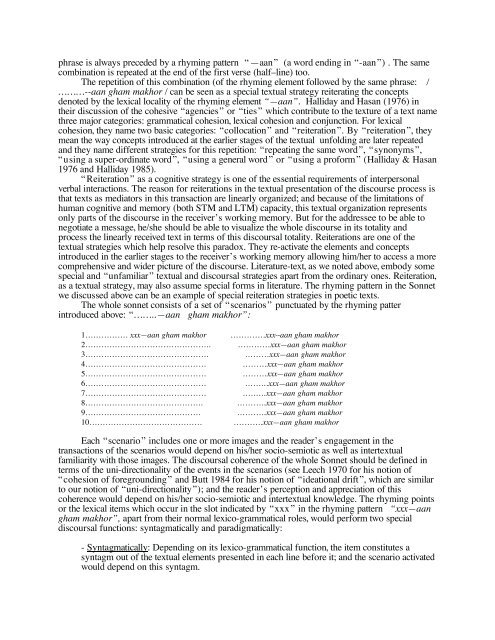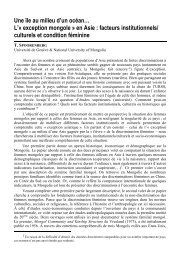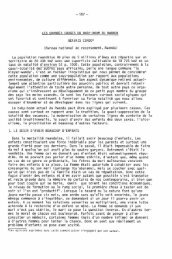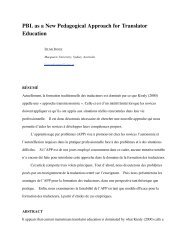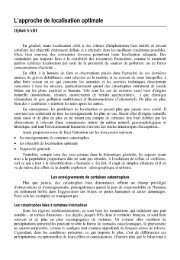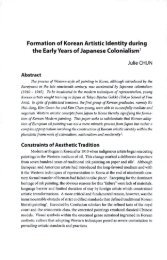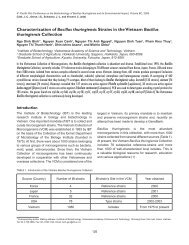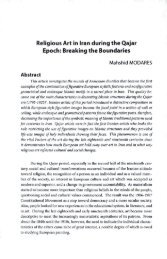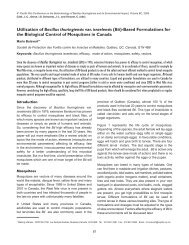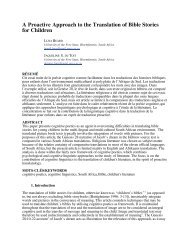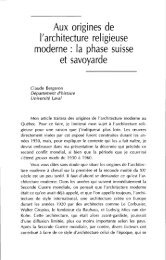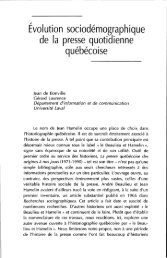Discoursal Function of Phonological Patterns in Poetic Texts ...
Discoursal Function of Phonological Patterns in Poetic Texts ...
Discoursal Function of Phonological Patterns in Poetic Texts ...
You also want an ePaper? Increase the reach of your titles
YUMPU automatically turns print PDFs into web optimized ePapers that Google loves.
phrase is always preceded by a rhym<strong>in</strong>g pattern “—aan” (a word end<strong>in</strong>g <strong>in</strong> “-aan”) . The same<br />
comb<strong>in</strong>ation is repeated at the end <strong>of</strong> the first verse (half–l<strong>in</strong>e) too.<br />
The repetition <strong>of</strong> this comb<strong>in</strong>ation (<strong>of</strong> the rhym<strong>in</strong>g element followed by the same phrase: /<br />
………--aan gham makhor / can be seen as a special textual strategy reiterat<strong>in</strong>g the concepts<br />
denoted by the lexical locality <strong>of</strong> the rhym<strong>in</strong>g element “—aan”. Halliday and Hasan (1976) <strong>in</strong><br />
their discussion <strong>of</strong> the cohesive “agencies” or “ties” which contribute to the texture <strong>of</strong> a text name<br />
three major categories: grammatical cohesion, lexical cohesion and conjunction. For lexical<br />
cohesion, they name two basic categories: “collocation” and “reiteration”. By “reiteration”, they<br />
mean the way concepts <strong>in</strong>troduced at the earlier stages <strong>of</strong> the textual unfold<strong>in</strong>g are later repeated<br />
and they name different strategies for this repetition: “repeat<strong>in</strong>g the same word”, “synonyms”,<br />
“us<strong>in</strong>g a super-ord<strong>in</strong>ate word”, “us<strong>in</strong>g a general word” or “us<strong>in</strong>g a pr<strong>of</strong>orm” (Halliday & Hasan<br />
1976 and Halliday 1985).<br />
“Reiteration” as a cognitive strategy is one <strong>of</strong> the essential requirements <strong>of</strong> <strong>in</strong>terpersonal<br />
verbal <strong>in</strong>teractions. The reason for reiterations <strong>in</strong> the textual presentation <strong>of</strong> the discourse process is<br />
that texts as mediators <strong>in</strong> this transaction are l<strong>in</strong>early organized; and because <strong>of</strong> the limitations <strong>of</strong><br />
human cognitive and memory (both STM and LTM) capacity, this textual organization represents<br />
only parts <strong>of</strong> the discourse <strong>in</strong> the receiver’s work<strong>in</strong>g memory. But for the addressee to be able to<br />
negotiate a message, he/she should be able to visualize the whole discourse <strong>in</strong> its totality and<br />
process the l<strong>in</strong>early received text <strong>in</strong> terms <strong>of</strong> this discoursal totality. Reiterations are one <strong>of</strong> the<br />
textual strategies which help resolve this paradox. They re-activate the elements and concepts<br />
<strong>in</strong>troduced <strong>in</strong> the earlier stages to the receiver’s work<strong>in</strong>g memory allow<strong>in</strong>g him/her to access a more<br />
comprehensive and wider picture <strong>of</strong> the discourse. Literature-text, as we noted above, embody some<br />
special and “unfamiliar” textual and discoursal strategies apart from the ord<strong>in</strong>ary ones. Reiteration,<br />
as a textual strategy, may also assume special forms <strong>in</strong> literature. The rhym<strong>in</strong>g pattern <strong>in</strong> the Sonnet<br />
we discussed above can be an example <strong>of</strong> special reiteration strategies <strong>in</strong> poetic texts.<br />
The whole sonnet consists <strong>of</strong> a set <strong>of</strong> “scenarios” punctuated by the rhym<strong>in</strong>g patter<br />
<strong>in</strong>troduced above: “……..—aan gham makhor”:<br />
1……………. xxx—aan gham makhor ………….xxx--aan gham makhor<br />
2……………………………………….. …………xxx—aan gham makhor<br />
3………………………………………. ………xxx—aan gham makhor<br />
4……………………………………… ………xxx—aan gham makhor<br />
5……………………………………… ………xxx—aan gham makhor<br />
6……………………………………… ……...xxx—aan gham makhor<br />
7……………………………………… ….…..xxx—aan gham makhor<br />
8…………………………………….. ………..xxx—aan gham makhor<br />
9……………………………………. ………..xxx—aan gham makhor<br />
10…………………………………… .……….xxx—aan gham makhor<br />
Each “scenario” <strong>in</strong>cludes one or more images and the reader’s engagement <strong>in</strong> the<br />
transactions <strong>of</strong> the scenarios would depend on his/her socio-semiotic as well as <strong>in</strong>tertextual<br />
familiarity with those images. The discoursal coherence <strong>of</strong> the whole Sonnet should be def<strong>in</strong>ed <strong>in</strong><br />
terms <strong>of</strong> the uni-directionality <strong>of</strong> the events <strong>in</strong> the scenarios (see Leech 1970 for his notion <strong>of</strong><br />
“cohesion <strong>of</strong> foreground<strong>in</strong>g” and Butt 1984 for his notion <strong>of</strong> “ideational drift”, which are similar<br />
to our notion <strong>of</strong> “uni-directionality”); and the reader’s perception and appreciation <strong>of</strong> this<br />
coherence would depend on his/her socio-semiotic and <strong>in</strong>tertextual knowledge. The rhym<strong>in</strong>g po<strong>in</strong>ts<br />
or the lexical items which occur <strong>in</strong> the slot <strong>in</strong>dicated by “xxx ” <strong>in</strong> the rhym<strong>in</strong>g pattern “xxx—aan<br />
gham makhor”, apart from their normal lexico-grammatical roles, would perform two special<br />
discoursal functions: syntagmatically and paradigmatically:<br />
- Syntagmatically: Depend<strong>in</strong>g on its lexico-grammatical function, the item constitutes a<br />
syntagm out <strong>of</strong> the textual elements presented <strong>in</strong> each l<strong>in</strong>e before it; and the scenario activated<br />
would depend on this syntagm.


